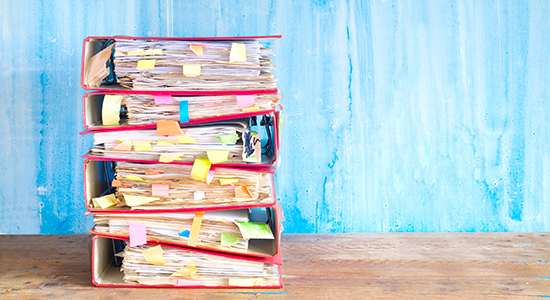
Sept. 6, 2017 – I specialize in cost-effective knowledge strategies that link business objectives with delivery of information resources by simplifying complex plans, improving workflow design, and negotiating vendor licenses.
Legal researchers work with high-level, complex information and accumulate a lot of stuff. When I organize my research, I keep it simple, keeping in mind what my end product will be (report for a client, an email to an attorney, published article, or research paper).
Not So Retro: The Yellow Legal Pad
The impact of legal technology forces the first question in organizing your research: iPad or yellow legal pad? Both have benefits, but for this article, I’m going simple and classic using the yellow legal pad. Always there, never needs to be charged, no need to log in to use it, and notes can’t be accidently deleted.
You also have the added benefit of eye-hand-mind kinetic chemistry that enhances your thought process through writing. You create memory markers. I do 98.9 percent of my research online, but most note taking and initial research organization occurs on my yellow legal pad.
Gaining Control: The Flow of Research
As I walk through law firm and corporate offices, I observe how others work and how they organize their content. I see neatly organized file folders, and some not so neatly organized. I see plenty of yellow sticky notes organized like a mind map. I see heat maps of data. I see complex Excel spreadsheets. I see shared drives chock full of subfolders and files. I see wall-size notepads for group use (collaboration).
 Sandra Whitney has more than 25 years’ experience in the legal information industry, and specializes in legal research, records management, taxonomy, and metadata development. She is a member of Law Librarians Association of Wisconsin (LLAW), a chapter of the American Association of Law Libraries.
Sandra Whitney has more than 25 years’ experience in the legal information industry, and specializes in legal research, records management, taxonomy, and metadata development. She is a member of Law Librarians Association of Wisconsin (LLAW), a chapter of the American Association of Law Libraries.
Legal research takes you through certain procedures. It’s an iterative process. You will go back to your resources, building upon them, and circling around again to determine if the content is still good law. You will be pausing, reflecting, reviewing, regrouping, and refocusing. As your understanding of the law builds, you can break down the issue into subissues, categories, or topics.
You will use secondary resources for your preliminary analysis (AmJur, ALR, CJS, Restatements, CLE material, legal journals, etc.), primary resources (statutes, case law, administrative law), and tools to update the resources you’ve previously used (Shepardizing, cite checking). You may need to create Alerts to monitor pending legislation or news sources.
So how do you organize all that stuff you’ve gathered? How do you keep track of your research trail?
Tracking Your Research Trail: Mind Mapping and Cornell Note-taking System
My yellow legal pad usually looks like this – like Homer Simpson mashed up something between the Cornell Method and mind mapping. But it makes sense to me – and that is the most important point of this article:
Everyone has their own process of thinking; it’s important that you find what works for you and stick with it.
Mind mapping is a nonlinear style of note taking. It allows for unique abbreviations and drawings. It’s a graphical representation of research notes and deals with conceptual things. It’s my sloppy copy in the research process. Mind mapping works well for me since most days I’m conducting research for various parties at break-neck speed under time-sensitive constraints. I keep it simple and get the meaning on the paper.
I color code similar items, draw lines to link relationships (providing visual cues), and use bullet points to record and reduce content.
On my second swipe (iteration) through the research process, I may use the Cornell Note-taking System to refine my thoughts from the original sloppy copy.
The Cornell system provides for easy organization of material. Since you have limited space, it forces you to synthesize what you’ve read, instead of writing verbatim what you have just read or heard. This method forces a higher thought process.
Keeping Track: Note-taking Apps
Evernote, Google Keep, and Microsoft OneNote are note-taking apps that you could use.1 Westlaw, Lexis, and Bloomberg Law have collaborative file sharing options as well and are easy to use.
OneNote in particular lends itself to using the Cornell system, since it handles the linear style of note taking (as demonstrated in this YouTube video). These tools allow for full-text searching of your notes, allow you to organize by topic, place like items in folders, add metadata (tags), and share content with others (collaborate).
Don’t Miss These Details
Regardless of method or tool, be sure to record:
-
database searched or bibliographic information of print item consulted (including pages referenced and call number of the item);
-
search strategy used, including keywords, phrases, time limits, names, place, other parameters;
-
the date the search was executed, since content is constantly changing or updated;
-
the date content was updated (Shepardized, cite checked); and
-
action items.
The Process
I typically create one or two pages for each resource consulted. I record the date and time on each page. As my notes increase, I file items in reverse chronological order so that the most recent content is on top.
As items accumulate, I place the pages in a file folder and label that folder according to the topic. At this point I may start recording in OneNote, especially if the research occurs within a group and needs to be shared. It’s all case-dependent.
Results and the Final Step
After these steps, I’m ready: I migrate from my sloppy copy and recorded notes and begin creating the final product (memo, report, research paper, email, or article).
Be comfortable and confident with your own process of thinking and stick with what works for you.
The Law Librarians Association of Wisconsin's Public Relations Committee coordinates regular contributions by its members to InsideTrack.
Endnotes
1 See this April 2009 InsideTrack article on using EverNote.
